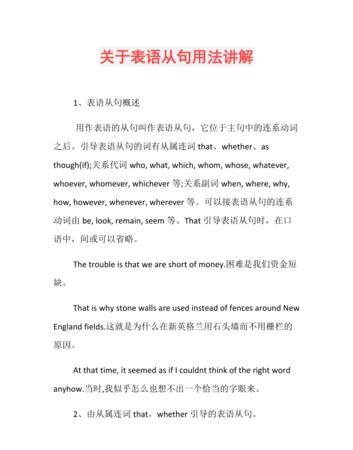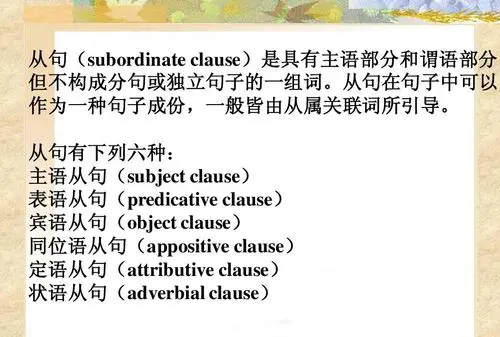本文目录
表语从句中what和who的用法
导语: 表语从句在一个 复合句中,从句作的是主句的表语成分。下面我为您收集整理了英语表语从句的用法,希望对您有帮助!
表语从句的定义:
A. 表语从句就是用一个句子作为表语。说明主语是什么或者怎么样,由名词、形容词或相当于名词或形容词的词或短语充当,和连系动词一起构成谓语。
例句:The problem is when we can get a pay rise. 问题是,当我们可以得到加薪。
B. 连接表语从句的连接词有:that, what, who, when, where, which, why。例句:
He has become what he wanted to be ten years ago.
他已经成为了他10年前想成为的。
She has remained where I stood yesterday for an hour.
她一直在我昨天站的地方站了一个小时。
His suggestion is that we should stay calm.
他的建议是,我们应该保持冷静。
The question is when he can arrive at the hotel.
问题是,他什么时候可以到达酒店。
表语从句的.注意事项:
A. 表语从句一定要用陈述语序。
False: The question is when can he arrive at the hotel.
Right: The question is when he can arrive at the hotel.
B. 不可以用if,而用whether连接表语从句(as if 例外);
引导宾语从句时可以互换if/whether,位于介词后要用whether;
位于句首时要用whether;
引导表语从句,主语从句,同位语从句时要用whether。
False: The question is if the enemy is marching towards us.
Right: The question is whether the enemy is marching towards us.
Right: It looked as if he had understood this question.
C. 不像宾语从句,在有表语从句的复合句中,主句时态和从句时态可以不一致。
Right: The question is who will travel with me to Beijing tomorrow.
Right: The question is why he cried yesterday.
D. that在表语从句中不可以省掉。
表语从句的基本用法:
表语从句只能置于主句之后,而主句的动词只能是联系动词。
名词性从句在be等系动词后作表语时被称为表语从句,例如:
The problem is how we can get the things we need. 问题是我们怎样能弄到我们需要的东西。(how 在表语从句中充当方式状语)
The scissors are not what I need. 这把剪刀不是我所需要的。(what在表语从句中充当宾语)
What I told him was that I would find him a good play. 我告诉他的是我会给他找个好剧本。(what在主语从句中作直接宾语,that作为表语从句的引导词在该表语从句中不充当句子成分,不能省略)
That is what I want to tell you. 那就是我想要对你讲的。(what在表语从句中充当直接宾语)
That is why she failed to pass the exam. 那就是她考试不及格的原因。(why在表语从句中充当原因状语)
注意:“That is why...”是常用句型,意为“这就是……的原因/因此……”,其中why引导的名词性从句在句中作表语,该句型通常用于针对前面已经说明过的原因进行总结,又如:That is why you see this old woman before you know, Jeanne. 珍妮,这就是现在这个老太婆出现在你面前的原因。(前文提到Jeanne对老妇人显得苍老憔悴深感诧异,说话人对她讲述了其中的原因之后,用这一句来进行概括)。
下面是两个与“That is why...”形式相似的结构,它们与“That is why...”结构之间的关系要能够辨析清楚:
(1)“That is why...”与“That is the reason why...”同义,只不过从语法结构上讲,“That is the reason why...”中why引导的是—个定语从句,将其中的the reason去掉则与“That is why...”结构一样,例如:
That is (the reason) why I cannot agree. 这就是我不能同意的理由。
(2)“That is because...”句型中从属连词because引导的名词性从句在此作表语,这也是个常用句型,意为“这就是为什么……/因为……”。“That is because...”与“That is why...”之间的不同在于“That is because...”指原因或理由,“That is why...”则指由于各种原因所造成的后果, 例如:
He did not see the film last night. That is because he had to help his little sister with her homework. 昨天晚上他没有去看电影,那是因为他得帮助他的妹妹做作业。(第一句话说明结果, 第二句话说明原因)
He had seen the film before. That is why he did not see it last night. 他以前曾看过那部电影,因此他昨天晚上没有去看。(第一句话说明原因,第二句话说明结果)

英语八大从句类型与用法总结图
根据从句语法功能的不同可分为:主语从句、表语从句、宾语从句、同位语从句、定语从句和状语从句6类。
1、主语从句
主语从句就是作主语的从句。它的连接词有连词、连接副词、连词代词。主语从句放在句首时,句子显得很笨重,因此常用it作形式主语,而将真正的主语后置,比如:
It is a pity that you have missed such a wonderful concert.
真遗憾你错过了这么精彩的一场音乐会。
2、表语从句
表语从句就是作表语的从句。它的连接词有连词、连接副词、连词代词等。
比如:
My idea is that we meet at the bus stop.
我的想法是我们在公共汽车站会面。
3、宾语从句
宾语从句就是作宾语的从句。它的连接词有连词、连接副词、连词代词等。
比如:
She said that she would drop maths.
她说她要放弃数学。

4、同位语从句
同位语从句就是作同位语的从句,它的连接词有连词、连接副词等。
The fact that everyone loves beauty is common sense.
人人爱美是常识。
5、定语从句
定语从句就是作定语的从句。定语从句主要修饰、限定、描绘名词,有时修饰代词,放所修饰词后边。
比如:
The girl who wears a new dress is my daughter.
那个穿新衣服的女孩是我的女儿。
6、状语从句
状语从句就是作状语的从句。在复合句中修饰主句中的谓语动词、形容词或副词,起状语作用的从句叫作状语从句。
比如:
Soon after he jumps his parachute will open.
他跳伞之后,降落伞就会打开。
英语各种从句的总结
各种从句的语法总结
导语:高级的英语语法知识比初级英语的要难得多,下面我分享高级英语的重要语法,欢迎学习!

虚拟语气在各种从句的应用
主语从句的虚拟
1. It is + adj. + that sb. (should) do
常见的形容词有:necessary, important, strange, natural
It's important that he take my advice.
2. It is + n. + that sb. (should) do
常见的名词有:a pity, a shame, no wonder, one's wish
It's a pity that he be so silly.
3. It is + done + that sb. (should) do
常见的过去分词有:suggested, advised, demanded, requested, required, asked, ordered,
proposed, decided, desired, insisted等。
It's requested that she go home as soon as possible.
宾语从句的虚拟
1. 表命令,表建议,表要求的动词,后接宾语从句虚拟。虚拟的构成为(should) do。
I advise that he stay at home.
2. wish后接从句,虚拟的构成是往过去推一个时态。
I wish I had watched the football match last night.
注意以下几组词或短语用于虚拟语气中。
1. as if, as though
He speaks English as if he were a native speaker.
2. otherwise, but, even though
He was ill. Otherwise he would have been there.
3. with, without, but for
Without your help, I would have died two years ago.
But for your help, I would have died two years ago.
4. would rather I'd rather you told me yourself.
5. It's time that
It's time that you went to bed.
It's time that you should go to bed.
表语从句中的虚拟
在表语从句中,表示间接的命令,要求、请求、建议、决定等,主句中的主语通常是suggestion, proposal, request, orders, idea等。从句谓语形式是"(should)+动词原形"。如:
His suggestion is that we (should) leave at once.
名词从句部分:
1. that不可省略的情况
2. that引导同位语从句和that引导定语从句的区别:同位语从句中的that是连词,不做成分,只连接主从句,不能省略;定语从句中的'that要代替先行词在从句中做主语、宾语或者表语,并且做宾语时可以省略。从语义上看,同位语从句是对前面名词的解释、说明或内容;而定语从句时对前面名词的限定。
We should consider the students’request that the school library provide more books on
popular science. (that引导同位语从句)
The only hope that he expressed was that they would do what they could to help the people
in disaster areas. (that引导定语从句)
3. 要根据句子结构尤其是谓语动词判断从句的类型:
What is known to us all is that the 2008 Olympic Games took place in Beijing.
本句含有一个主语从句和一个表语从句,主句的动词为is。
It is known to us all that the 2008 Olympic Games took place in Beijing.
本句含有一个主语从句,主句的动词为is known to。
As is known to us all, the 2008 Olympic Games took place in Beijing.
本句含有一个定语从句,主句的动词为took place,as引导非限制性定语从句。
4. 名词性从句的语序和语态。
名词性从句均应用陈述语序,不能用疑问语序,其时态应该和主句时态保持一致。
5. 名词性从句中连词的省略 。
介词后的连词以及引导主语从句和同位语从句的连词不可省略。that引导名词从句(除了引导第一个宾语从句可省略外)都不可省略,但是引导定语从句并在从句中做宾语时可以省略。 that不能省略的情况:1)介词后面的that不能省略:
Peter is a good student except that he is sometimes careless.
2)当that引导的宾语从句位于句首时:
That he ever did such a thing I don’t believe.
3)主句谓语动词和that从句之间有插入语,that不省略:
She said that, if she failed, she would try again.
4)当宾语从句有其他从属连词时,that不省略:
He told me that if it was necessary they would work extra time.
6.名词性从句中it的使用:
为了保持句子平衡,多数情况下,it作形式主语或形式宾语,将真正的主语或宾语从句后置。 定语从句关系代词有who, whom, whose, which, that, as,和关系副词when, where, why。
(1)that指物时一般可与which互换,但在下列情况下,要用that而不用which。
a. 先行词有all, everything等不定代词时,如,
Everything (that) he did is wrong.
b. 先行词被all, every, no, some, any, little, much等修饰时,如,
I'll read all the books (that) you lend me.
c. 先行词被序数词或形容词最高级修饰时,
This is the first letter (that) the boy has written.
d. 先行词被the only, the very, the same, the last修饰时,如
He is the very man (that) I'm looking for.
e. 只用which的情况
在介词后或在非限定性定语从句中
This is the book about which we have talked a lot.
The book, which he gave me yesterday, is very interesting.
f. where和when作关系副词
This is the room where I worked.
This is the room which I stayed in.
I remembered the day when we lived there.
I remembered the day that I spent there.
g. as和which
as 可以放于句首,而which 不可以
As you know, he is good at English.
three of them 和three of which
I have a lot of books, three of which are in Russian.
I have a lot of books and three of them are in Russian.
(2. )“介词+关系代词”的情况:
在固定短语中介词不能提前;判断介词的口诀:瞻前顾后看意义
瞻前——看先行词;顾后——找从句动词;看意义——看全句表达含义
(3. )先行词在从句中充当地点状语时,关系词用where 或者介词加which;先行词在从句中充当时间状语时,关系词用when或者介词加which;先行词在从句中充当原因状语时,关系词用why或者for which。
(4. )注意as和which在非限制性定语从句中代表主句所表达的内容的区别:
位置不同:as从句放在主句前或后均可;而which从句只能放在主句后
作用不同:as从句动词常常是see \know等,因而相当于插入语;which从句则在陈述一件事实。
状语从句部分
1.while 是高考中的高频词,它既可引导时间状语从句,又可引导并列句,还可引导让步状语从句,表示“尽管”。
2. no matter wh- 与wh-ever 的联系及区别:no matter wh- 只引导让步状语从句,此时与wh-ever通用。wh-ever又可引导名词性从句,No matter wh-不能。
No matter when / Whenever he comes back, he should be invited to the party.
3. 在条件,时间和让步从句中,用一般现在时表示一般将来时,用现在完成时表将来完成时,
用一般过去时表过去将来时。在since 引导的时间状语从句中,动词一般都用一般过去时,而主句常用现在完成时。
4. 状语从句的倒装一般有下面几种情况:①否定词开头;②so 加adj. 开头;③as /
though引导的让步状语从句。
5. 连词before小结:
We had sailed four days before we saw land. (……才)
We hadn’t run a mile before he felt tired. (不到……就)
Please write it down before you forget it. (趁……)
Before I could get in a word, he had measured me. (还没来得及)
It will be/was…before…要过多久才……
6. because, since, as 引导原因从句的区别:because表达直接原因,语气最强,回答why;
since通常放句首,译为“既然”;as引导不谈自明的原因,语气最弱;
7. as可以引导多种从句,要注意其中的区别。
8. till, until和not…until的区别;if和unless的区别
非谓语动词部分动词不定式几点注意。
1.下列动词或动词短语后接不定式:agree, seem, appear, offer, happen, wish, hope, pay,
expect, long, plan, intend, promise, pretend, decide, afford, manage, choose, be said to,would like to等。
2. 不定式常用的句型:too…to do (太……而不能), …enough to do…(够……就能……), so as to do/in order to do(为了……),so…as to do/such…as to do(如此……结果……)。
3. 不定式的三个结构:即否定结构、复合结构和疑问结构。
否定结构为“not (never) to do”;疑问结构是特殊疑问词“how (what, which, who, whether…) to do”;复合结构是“for/ of +名词(或代词宾格)+ to do ”。
4. let/ make/ have/ see/ hear/ notice/ observe/ listen to/ look at/ watch/feel
这些动词带不定式作宾补时,省掉to, 若这些动词以被动形式出现时,应加上to。
5. 当前面是the first, the second, the last, need, plan, time, chance, right,determination,ability, opportunity(机会),way时,一般用不定式作定语。
6. but/ except + to do/ do 结构,要根据谓语动词来确定其后面的形式。当谓语动词是do,does, did时,but后用动词原形;谓语动词是其他动词时,but后用“to + 动词原形”的形式。
7. 形容词后一般用不定式(除busy, worth 两个外)。
You are sure to succeed. 你一定能成功。
He is busy preparing his lessons at present. 他现在正忙于预习功课。
8. 不定式作定语和表语时,有时需要在后面放上一个适当的介词。
This is a bench to sit on.(这是用来坐的凳子。)
This room is comfortable to live in. (这个房间住起来很舒适。)
9. 在“主语+系动词+adj.+不定式”这个句型中,当主语是不定式的逻辑宾语时,不定式不用被动,不能在动词后再放宾语。
The question is easy to answer. (question是answer的宾语,不能说:The question is easy to be answered. 也不能说:The question is easy to answer it .)
;表语从句用法详解

1. 表语从句只能置于主句后,主句的动词只能是连系动词。名词性从句在系动词后作表语时被称为表语从句。如:
① The problem is how we can get the things we need.
问题是我们怎样能弄到我们需要的东西。
(how 在表语从句中充当方式状语)
② The scissors are not what I need.
这把剪刀不是我所需要的。
(what在表语从句中充当宾语)
2. 注意:“That is why...”是常用句型,意为“这就是……的原因/因此……”,其中why引导的名词性从句在句中作表语,该句型通常用于针对前面已经说明过的原因进行总结。
辨析:
1)"That is why...”与“That is the reason why...”同义,但“That is the reason why...”中why引导的是定语从句,例如:
That is (the reason) why I cannot agree. 这就是我不能同意的理由。
(2)“That is because...”中从属连词because引导的名词性从句在此作表语,意为“这就是为什么……/因为……”。
“That is because...”指原因或理由,“That is why...”则指由于各种原因所造成的后果, 例如:
He did not see the film last night. That is because he had to help his little sister with her homework. 昨天晚上他没有去看电影,那是因为他得帮助他的妹妹做作业。
He had seen the film before. That is why he did not see it last night. 他以前曾看过那部电影,因此他昨天晚上没有去看。
本文载自微信公众号“英语语法学习”。本文已获转载授权,版权归作者所有,如需转载,请联系原微信公众号“英语语法学习”。

以上就是关于表语从句用法总结,表语从句中what和who的用法的全部内容,以及表语从句用法总结 的相关内容,希望能够帮到您。
